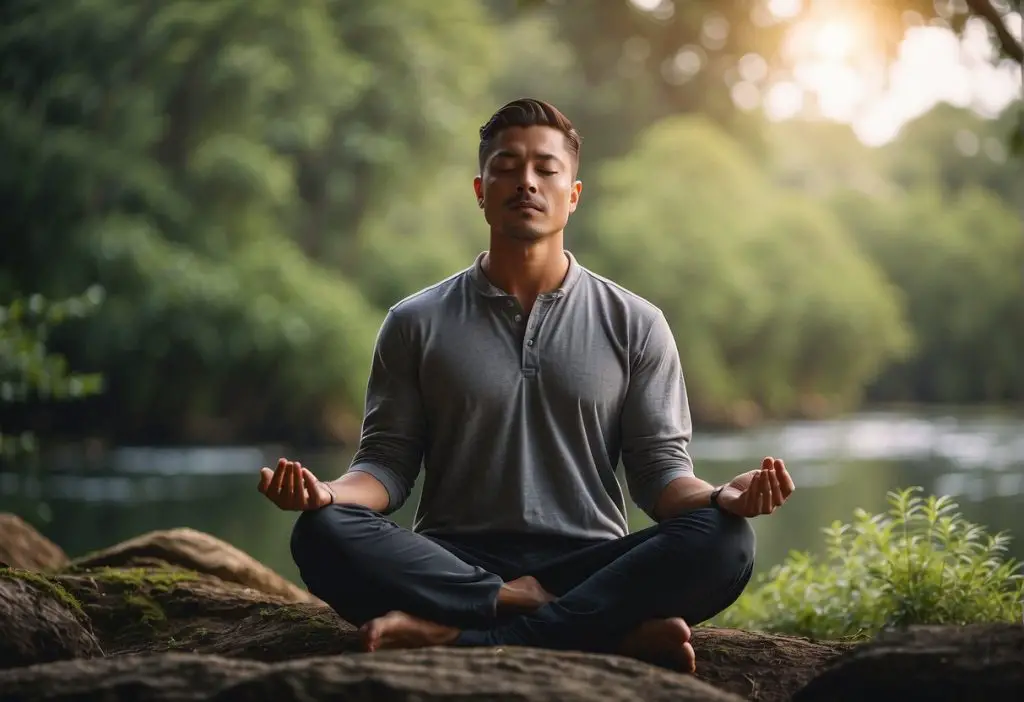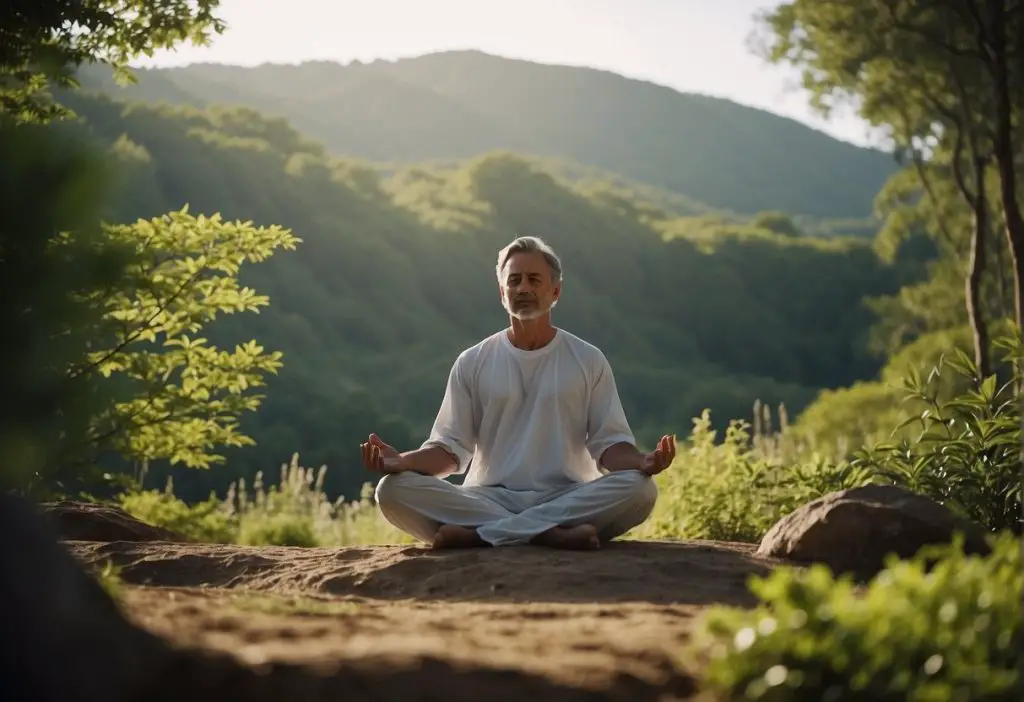Meditation has emerged as a popular tool for managing stress and boosting overall well-being. Individuals turn to the practice seeking a variety of benefits, including increased focus, improved emotional health, and enhanced self-awareness. While the advantages of meditation are well-documented, a common question persists: how much meditation is enough to reap its rewards?

Scientific studies have yet to pinpoint an exact duration that is universally optimal, leaving practitioners to navigate a range of recommendations. The duration of meditation can vary widely—a few minutes per day to several hours. What matters most is the quality of practice and consistency over time.
Incorporating meditation into one’s daily routine and adhering to it consistently appears to be more critical than the length of each individual session. Regular practice allows individuals to deepen their meditation experience and sustain the positive effects on their mental and emotional states. Whether meditating for five minutes or fifty, consistency remains a key factor in cultivating the mental acuity and peace associated with this ancient discipline.
The Essence of Meditation Practice
Meditation practice encompasses cultivating mindfulness and awareness through focused attention and intention. Achieving this state can offer various benefits to one’s mental and emotional well-being.
Understanding Meditation
Meditation is the process of training one’s mind to focus and redirect thoughts. The practice enhances awareness of the present moment through mindfulness, an attentive observation of the here and now. The key elements of meditation include:
- Mindful Breathing: Inhale deeply and exhale slowly, concentrating solely on the breath.
- Attention to the Present: Be aware of sensations, thoughts, and your environment without judgment.
Setting Intentions and Goals
Goals in meditation are personal and should be considered thoughtfully. Starting with clear intentions can significantly enhance the meditation experience by providing direction and a sense of purpose. Considerations for setting goals include:
- Duration: Begin with short sessions, incrementally increasing time as comfort grows.
- Frequency: Regular practice, even for just a few minutes daily, can be more beneficial than occasional extended sessions.
Establishing goals and regularly assessing progress can contribute to a fulfilling meditation practice.
Benefits of Regular Meditation
Regular meditation offers a multitude of benefits that encompass mental, physical, and emotional well-being. The practice has been linked to significant improvements in various health aspects.
Mental Health Advantages
Meditation is highly effective for mental health, providing a substantial reduction in stress and anxiety levels. Studies have shown that meditation can physically change the brain, enhancing areas responsible for memory and decision-making while decreasing those associated with anxiety and stress. For example:
- Stress Reduction: Mindfulness meditation has been found to reduce the production of the stress hormone cortisol.
- Anxiety and Depression: Regular practice leads to lower anxiety levels and can be an adjunct to the treatment of depression.
Physical Health Improvements
The benefits of meditation also extend to one’s physical health. Research suggests meditation can lead to:
- Health Maintenance: Improved immune response and energy level stabilization.
- Physical Health Conditions: Reduction in symptoms of physical stress-related conditions such as hypertension, reducing the risk of associated diseases.
Emotional and Social Benefits
Meditation fosters emotional health, enhancing self-awareness and promoting a sense of calm and balance. It has a ripple effect on social interactions by improving empathy and connectivity with others. Notably:
- Emotional Well-Being: Meditation can help individuals gain a new perspective on stressful situations, build skills to manage stress, and develop a deeper sense of self-awareness.
- Social Connections: Those who meditate regularly often experience more positive emotions, which can contribute to stronger social relationships.
Determining the Optimal Duration
Finding the right amount of time to dedicate to meditation can vary by individual, but research and expert advice offer benchmarks.
What Studies Show
Studies typically suggest starting with shorter sessions for beginners. The Journal of Positive Psychology published research indicating that just 15 minutes of meditation may enhance mood and problem-solving skills. A meta-analysis in JAMA Internal Medicine reviewed a multitude of studies and proposed that sessions lasting 10-30 minutes for 8 weeks showed improvements in mental well-being.
- Minimum Duration: Research often cites 10 minutes as a productive starting point.
- Recommended Duration: Most studies converge on 20-30 minutes daily for sustained benefits.
Meditation Teacher Insights
Meditation teachers, drawing on empirical experience, reinforce that the quality of practice matters as much as duration. They observe that monks and nuns may meditate for several hours daily, but for laypersons, consistency is key.
- For Beginners: Most recommend starting with 15-minute sessions.
- For Regular Practitioners:
- Demystifying Duration: While there’s no one-size-fits-all answer, they emphasize regularity over lengthier, less frequent sessions.
- Tailored Practice: They suggest that individuals should tailor the duration to fit their lifestyle and goals, gradually increasing time as comfort with the practice grows.
Incorporation into Daily Life
Incorporating meditation effectively into one’s daily life requires a mix of consistency and adaptability. Mastering this balance can lead to sustained self-care and mindfulness.
Creating a Consistent Routine
A fundamental step in establishing a meditation practice is setting a consistent routine. Beginners can start with as little as five minutes per day and gradually increase this time.
- Time of Day: Opt to meditate at the same time each day, whether it’s morning or evening, to anchor the habit in your schedule.
- Duration: Consistency matters more than duration; even a short period of daily meditation can be beneficial.
- Location: While having a designated space can be helpful, flexibility is key. If a dedicated spot isn’t available, any quiet space will suffice.
Meditation in Various Settings
While consistency is important, one can also practice meditation in various settings to adapt to a dynamic lifestyle.
- Home: The primary location for meditation, ensuring privacy and quietness.
- Work: Take short meditation breaks to recenter; even a few moments of deep breathing can suffice.
- Nature: Engaging with the present moment can be enhanced by meditating outdoors, in parks, or natural settings.
In both routine creation and practice environments, it is the commitment to being present in the moment and the regularity of the activity that forge the path to a mindful life.
Advanced Meditation Practices
In the realm of advanced meditation, individuals often enhance their practice through specific, structured programs like Mindfulness-Based Stress Reduction and by participating in meditation retreats that encourage deep immersion.
Mindfulness-Based Stress Reduction
Mindfulness-Based Stress Reduction (MBSR) is an evidence-based program designed to alleviate stress and improve mental health. MBSR typically involves an eight-week course combining mindfulness meditation and yoga, with a key component being the sustained practice of mindfulness in daily life. Participants engage in:
- Structured Activities: guided meditations, stretching, and mindful yoga.
- Weekly Sessions: totaling 2.5 hours, plus a day-long silent retreat.
- Homework: participants are encouraged to practice mindfulness exercises for 45 minutes per day, six days a week.
Exploring Meditation Retreats
Retreats offer a deeper dive into meditation, often in tranquil settings away from daily distractions. They can range from weekend retreats to extensive stays, with some programs modeled after traditional practices such as Meditation 2.0. Retreats typically emphasize:
- Immersive Experience: uninterrupted practice, ranging from silence to guided meditations.
- Integration: techniques to incorporate learnings into everyday living.
- Variety: different types of meditation, including mindfulness meditation and other forms.
| Factors to Consider in Retreats | Description |
|---|---|
| Duration | Ranging from a couple of days to several weeks. |
| Intensity | May involve many hours of meditation per day. |
| Types of Meditation | Retreats may specialize in certain meditation styles. |
| Instructor Expertise | Quality of instruction can significantly impact experience. |
| Post-Retreat Support | Resources available to help maintain practices post-retreat. |
Addressing Common Challenges

Many individuals face obstacles when they begin to incorporate meditation into their routine. By understanding common challenges, they can develop strategies to maintain a consistent practice.
Overcoming Distractions and Fears
When beginners start meditating, their minds often wander, pulling their attention away to various distractions. These distractions can be external, such as noises or physical discomforts, or internal, like intrusive thoughts or emotions. To overcome distractions, a structured approach is recommended:
- Set a Conducive Environment: Choose a quiet, comfortable space to minimize external distractions.
- Focus Techniques: Use a focal point, such as the breath or a mantra, to gently guide attention back when it wanders.
Fear can also be a significant hurdle. Beginners may fear the self-reflective aspect of meditation or worry about not doing it ‘right.’ To address these fears, individuals should:
- Develop trust in the process, understanding that meditation is a skill that improves over time.
- Remember that being reactive to these fears only increases their power. Instead, acknowledging fears without judgment can diminish their impact.
Adapting to the Learning Curve
Meditation is a skill, and like any skill, it has a learning curve. For beginners, the progression might feel slow, causing frustration or impatience. It’s essential to:
- Recognize that learning to meditate is a process that involves both mental and physical adaptations.
- Stay patient and give oneself time to develop the practice.
Here are some strategies to adapt to the learning curve:
- Keep a meditation log: Record experiences and progress, noting any patterns or improvements.
- Be consistent with practice: Short, daily sessions can be more beneficial than intermittent, longer ones.
By addressing these challenges directly, individuals can lay a strong foundation for their meditation practice, eventually integrating it as a rewarding part of their daily life.
Maximizing the Effectiveness
Finding the right balance in meditation practice can significantly enhance its benefits. This involves setting optimal conditions and understanding the interplay between effort and relaxation.
Optimal Conditions for Meditation
Creating an environment conducive to meditation is crucial. The following elements can help:
- Place: A quiet, clean, and uncluttered space enhances concentration.
- Posture: One should adopt a comfortable position that promotes balance and alertness.
- Time of day: Regularity is key, with many finding early morning or evening conducive times.
| Factor | Why It Matters |
|---|---|
| Quiet Setting | Minimizes distractions, allowing for deeper attention. |
| Comfort | Reduces physical strain, aiding in prolonged sessions. |
| Regularity | Builds a habit, contributing to long-term well-being. |
Balancing Effort and Relaxation
The effectiveness of meditation hinges on the interplay between concentration (effort) and relaxation. They are not opposing forces but complementary.
- Concentration: It involves directing and sustaining attention on a chosen object or process.
- Relaxation: It should not be conflated with sleepiness but seen as a releasing of tension to facilitate a natural state of alertness.
By integrating concentration with relaxation, a meditator can maintain a balanced state where the mind is focused yet at ease, which is pivotal for a fruitful practice.
Special Considerations and Adaptations

The effectiveness of meditation can be influenced by individual health conditions and life stages. Tailoring meditation practices is crucial for maximizing benefits and ensuring safety.
Meditation for Health Conditions
Asthma: Meditation may support respiratory health by reducing stress, which is known to exacerbate asthma. Breathing-focused techniques should be approached with caution, and individuals should consult with healthcare providers before beginning any new meditation practices.
- Cancer: Stress reduction through meditation can be beneficial for individuals with cancer. It may improve mood and enhance quality of life during treatment.
- Chronic Pain: Mindfulness-based meditation helps some patients manage pain, increasing tolerance and altering their perception of pain intensity.
- Heart Disease: Practices that encourage relaxation and stress management may contribute positively to heart health, potentially lowering blood pressure and reducing strain on the cardiovascular system.
- High Blood Pressure: Meditation can be an adjunctive method to traditional treatments for lowering blood pressure by promoting relaxation and reducing stress.
- Sleep Problems: Techniques that induce relaxation can help improve the quality of sleep and address issues like insomnia.
Variations for Different Life Stages
Children and Adolescents: They may require shorter, engaging sessions tailored to their attention spans and developmental levels. Meditation can promote emotional regulation and stress management.
- Adults: The full spectrum of meditation practices can be beneficial at this stage, with adaptations made for personal preferences and time availability.
- Seniors: Gentle meditation practices can be particularly beneficial for older adults, taking into account any mobility limitations and focusing on stress reduction, cognitive function, and overall well-being.
Evaluating Progress and Outcomes
Meditation practice is assessed through observing changes in one’s emotional and mental states. This section will help individuals understand how to monitor and adapt their practice based on the outcomes they experience.
Tracking Meditation Results
Consistency and duration of practice are common metrics for tracking meditation. Individuals may use journals or apps to document their sessions, noting changes in their emotional state, such as levels of pain or joy they experience, or any shifts in perspective and memory functions. These observations can be tracked using a simple table:
| Date | Duration | Emotional State | Cognitive Changes |
|---|---|---|---|
| 2023-12-20 | 30 minutes | Reduced pain | Enhanced memory |
| 2023-12-21 | 45 minutes | Increased joy | Broader perspective |
Mindfulness measurement tools, such as questionnaires, can quantify one’s progress in developing traits like compassion and happiness, indicating the effectiveness of the practice.
Adjusting for Positive Change
Adaptation is key when aiming for positive change. If increased happiness is observed, one might lengthen meditation sessions to reinforce this change. Conversely, should somebody experience discomfort, they might adjust their technique, perhaps incorporating guided meditation or focusing on compassion-centered practices.
Advancements can also be evaluated by the decrease in negative emotions or pain levels and an enhancement in positive emotions and mental clarity. It is advisable to make incremental changes and observe effects over a consistent period:
- Increase duration: If experiencing benefits, consider adding 5-10 minutes to each session.
- Change techniques: Address specific areas such as memory or perspective by trying different meditation styles.
- Seek feedback: Professional guidance can help tailor meditation practices to individual goals and needs.
By assessing outcomes and fine-tuning practices, one can maximize the benefits of meditation for personal growth and well-being.
Economic and Accessibility Factors

Engaging in meditation does not inherently require a significant monetary investment; however, some aspects of practice can involve costs. Individuals can achieve focused attention and an open attitude in a quiet setting without any expense. Accessibility is also a crucial factor, as meditation should be available to everyone, regardless of their economic status.
The Cost of Meditation
Meditation, in its basic form, is a cost-free practice. It can be done almost anywhere, requiring only time and focused attention. However, those seeking a structured approach may opt for guided meditation sessions, where costs can vary.
- Self-Guided Meditation: No direct costs; it may include free resources from books or the internet.
- Guided Meditation Sessions: Varying costs; can range from inexpensive online courses to premium-priced classes.
- Meditation Apps: Often operate on a freemium model; basic services are free, while advanced features may require a subscription.
| Type of Meditation | Cost Range |
|---|---|
| Self-Guided | Free |
| Guided Sessions | $10 – hundreds per session or course |
| Meditation Apps | Free – $60+ annually for subscriptions |
Making Meditation Accessible
Accessibility to meditation is key to ensuring that economic factors do not create barriers to its practice. Measures can be taken to improve accessibility:
- Community Programs: Offer free or donation-based sessions to reduce the financial burden.
- Online Resources: Utilize free content such as videos and podcasts to support an open attitude to meditation practices.
- Public Spaces: Encourage quiet settings in community centers and parks where individuals can meditate at no cost.
| Accessibility Measure | Description |
|---|---|
| Community Programs | Low to no cost options tailored to various income levels |
| Online Resources | Free instructional material |
| Public Spaces | Quiet settings that are openly available |
Providing a variety of options that cater to different financial situations and preferences ensures that the practice of meditation is an inclusive activity, supporting diverse needs for a calm and focused mental state.
Looking Forward: The Future of Meditation

The future of meditation hinges on technological innovation and global consensus, aiming to enhance inner peace through improved practices and guided instruction by skilled meditation teachers.
Innovation in Meditation Practices
Technological advancements are expected to introduce new methods for meditation, integrating devices and apps that track progress and offer personalized sessions. With the rise of virtual reality (VR), they could feasibly create immersive environments tailored to individual preferences, fostering deeper levels of tranquility. Upcoming AI-driven platforms may provide real-time feedback on techniques, ensuring practitioners maintain correct posture and breathing patterns.
Building a Global Meditation Consensus
A collective understanding is emerging, underscoring the vital role of meditation in mental health. Consensus among meditation teachers globally points to standardized practices that can be adopted across different cultures, increasing accessibility. Experts anticipate international symposiums and workshops spearheaded by renowned teachers, aimed at unifying meditation methodologies and teaching standards. This collective effort will likely facilitate a broader acceptance and integration of meditation in healthcare protocols, supporting individuals in achieving sustained inner peace.
